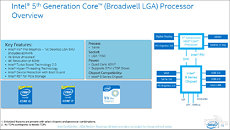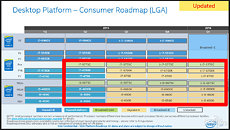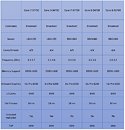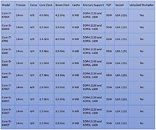- Joined
- Oct 9, 2007
- Messages
- 47,593 (7.45/day)
- Location
- Dublin, Ireland
| System Name | RBMK-1000 |
|---|---|
| Processor | AMD Ryzen 7 5700G |
| Motherboard | Gigabyte B550 AORUS Elite V2 |
| Cooling | DeepCool Gammax L240 V2 |
| Memory | 2x 16GB DDR4-3200 |
| Video Card(s) | Galax RTX 4070 Ti EX |
| Storage | Samsung 990 1TB |
| Display(s) | BenQ 1440p 60 Hz 27-inch |
| Case | Corsair Carbide 100R |
| Audio Device(s) | ASUS SupremeFX S1220A |
| Power Supply | Cooler Master MWE Gold 650W |
| Mouse | ASUS ROG Strix Impact |
| Keyboard | Gamdias Hermes E2 |
| Software | Windows 11 Pro |
Major pre-built desktop manufacturers began listing products driven by 5th generation Core "Broadwell" processors, which are having a brief stint at the markets before being replaced by 6th generation Core "Skylake" processors in Q3-2015. The 5th Generation Core family is led by two parts, the Core i5-5675C, and the Core i7-5775C, both of which come with unlocked base-clock multipliers, are based on Intel's new 14 nanometer silicon fab process, and built in the LGA1150 package, compatible with existing Intel 9-series chipset based motherboards, with BIOS updates.
The Core i5-5675C and i7-5775C aren't exactly successors of the i5-4690K and i7-4790K. The i7-5775C is placed in a product tier Intel calls "P1+," while the i5-5675C is placed in one called "MS2+." The two aren't exactly in the same plane as P1K (eg: i7-4790K) or MS2K (eg: i5-4690K), respectively, and don't qualify as P1 (eg: i7-4790 non-K) or MS2 (eg: i5-4690 non-K). The two still feature unlocked multipliers. This places them somewhere between P1K/MS2K and P1/MS2. Both the i5-5675C and i7-5775C are quad-core chips, and physically feature just 6 MB of L3 cache. The i7-5775C has access to all 6 MB of it, while the i5-5675K features just 4 MB.


Since "Broadwell" is an optical shrink of "Haswell" to 14 nm (à la "Ivy Bridge" being a 22 nm shrink of the 32 nm "Sandy Bridge"), it pays heavy dividends with energy efficiency. The two chips offer rated TDP of just 65W. Perhaps the biggest change between Broadwell and Haswell is the presence of a 128 MB eDRAM L4 cache for the Iris Pro 6200 series integrated graphics to use as a really quick scratchpad. The iGPU uses both this 128 MB cache, and the system memory for graphics, juggling hot data into the cache, and keeping less frequently accessed data into the system memory. The Iris Pro 6200 features 48 execution units, and supports DirectX 11.2.

Intel's big graphics push is driven not by its ambitions to eat into big-ticket PC gaming, but by two market forces
In addition to the Z170 Express chipset, PC enthusiasts should look out for two processors in particular - the Core i7-6700K and the Core i5-6600K. The two are the true successors to the i7-4790K and i5-4690K, occupying Intel's P1K and MS2K product tiers, respectively. The i7-6700K offers 4.00 GHz core clocks, with 4.20 GHz Turbo Boost, 8 MB of L3 cache, and HyperThreading. The i5-6600K, on the other hand, feature 3.60 GHz clocks, with 3.90 GHz Turbo Boost, 6 MB of L3 cache, but lacks HyperThreading. Both these chips feature TDP ratings of 95W.

View at TechPowerUp Main Site
The Core i5-5675C and i7-5775C aren't exactly successors of the i5-4690K and i7-4790K. The i7-5775C is placed in a product tier Intel calls "P1+," while the i5-5675C is placed in one called "MS2+." The two aren't exactly in the same plane as P1K (eg: i7-4790K) or MS2K (eg: i5-4690K), respectively, and don't qualify as P1 (eg: i7-4790 non-K) or MS2 (eg: i5-4690 non-K). The two still feature unlocked multipliers. This places them somewhere between P1K/MS2K and P1/MS2. Both the i5-5675C and i7-5775C are quad-core chips, and physically feature just 6 MB of L3 cache. The i7-5775C has access to all 6 MB of it, while the i5-5675K features just 4 MB.


Since "Broadwell" is an optical shrink of "Haswell" to 14 nm (à la "Ivy Bridge" being a 22 nm shrink of the 32 nm "Sandy Bridge"), it pays heavy dividends with energy efficiency. The two chips offer rated TDP of just 65W. Perhaps the biggest change between Broadwell and Haswell is the presence of a 128 MB eDRAM L4 cache for the Iris Pro 6200 series integrated graphics to use as a really quick scratchpad. The iGPU uses both this 128 MB cache, and the system memory for graphics, juggling hot data into the cache, and keeping less frequently accessed data into the system memory. The Iris Pro 6200 features 48 execution units, and supports DirectX 11.2.

Intel's big graphics push is driven not by its ambitions to eat into big-ticket PC gaming, but by two market forces
- The influx of high-resolution displays such as 4K (3840 x 2160 px) and 5K (5120 x 2880 px), which are being shrunk down in panel size and used to present high-DPI display-heads;
- MOBA games such as "League of Legends," which is a rare combination of low system requirements and high popularity that can be monetized in gaming tournaments and streaming
In addition to the Z170 Express chipset, PC enthusiasts should look out for two processors in particular - the Core i7-6700K and the Core i5-6600K. The two are the true successors to the i7-4790K and i5-4690K, occupying Intel's P1K and MS2K product tiers, respectively. The i7-6700K offers 4.00 GHz core clocks, with 4.20 GHz Turbo Boost, 8 MB of L3 cache, and HyperThreading. The i5-6600K, on the other hand, feature 3.60 GHz clocks, with 3.90 GHz Turbo Boost, 6 MB of L3 cache, but lacks HyperThreading. Both these chips feature TDP ratings of 95W.

View at TechPowerUp Main Site



 ). we all know that there is lack of competition for Intel, but it surprises me that Intel dose not want to compete for their old client money (those with Sandy, Ivy in their systems) - they have and had zero reasons to upgrade anything jet (except GPU - if they moved resolution up or had cheap GPU or SSD's).
). we all know that there is lack of competition for Intel, but it surprises me that Intel dose not want to compete for their old client money (those with Sandy, Ivy in their systems) - they have and had zero reasons to upgrade anything jet (except GPU - if they moved resolution up or had cheap GPU or SSD's).
 Q3 is just meh...
Q3 is just meh...


 (but they have money so they wan't "the best" for the money not the best for what they need)
(but they have money so they wan't "the best" for the money not the best for what they need)